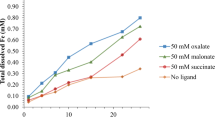Abstract
Phosphine is a toxic agent and part of the phosphorus cycle. A hitherto unknown formation mechanism for phosphine in the environment was investigated. When iron samples containing iron phosphide were incubated in corrosive aquatic media affected by microbial metabolites, phosphine was liberated and measured by gas chromatography. Iron liberates phosphine especially in anoxic aquatic media under the influence of sulfide and an acidic pH. A phosphine-forming mechanism is suggested: Phosphate, an impurity of iron containing minerals, is reduced abioticly to iron phosphide. When iron is exposed to the environment (e.g. as outdoor equipment, scrap, contamination in iron milled food or as iron meteorites) and corrodes, the iron phosphide present in the iron is suspended in the medium and can hydrolyze to phosphine. Phosphine can accumulate to measurable quantities in anoxic microbial media, accelerating corrosion and preserving the phosphine formed from oxidation.
Similar content being viewed by others
References
Gmelin Handbook of Inorganic and Organometallic Chemistry: Phosphorus. Suppl.Vol.C1. Berlin: Springer 1993
World Health Organization: Phosphine and selected metal phosphides. Environmental Health Criteria 73. Geneva 1988
Devai, I.;Felföldy, L.;Witther, L.:Plósz, S.: Detection of phosphine: New aspects of the phosphorus cycle in the hydrosphere. Nature 333 (1988) 343–345
Devai, I.;Delaune, R.D.: Evidence for phosphine production and emission from Louisiana and Florida marsh soils. Org.Geochem. 23 (1995) 277–279
Gassmann, G.;Glindemann, D.: Phosphine in the Biosphere: Angew. Chem.Intern.Edit. 32 (1993) 761–763
Glindemann, D.;Stottmeister, U.;Bergmann, A.: Free phosphine from the anaerobic biosphere. Environ.Sci. & Pollut.Res. 3 (1996) 17–19
Eismann, F.;Glindemann, D.;Bergmann, A.;Kuschk P.: Soils as a source and sink of phosphine. Chemosphere 35 (1997) 523–533
Glindemann, D.;Bergmann, A.;Stottmeister, U.;Gassmann, G.: (1996) Phosphine in the lower terrestrial troposphere. Naturwissenschaften 83 (1996) 131–133
Gassmann, G.;Glindemann, D..;van Beusekom, J.: Offshore Atmospheric Phosphine. Naturwissenschaften 83 (1996) 129–131
Nusch, E.A.;Poltz, J.;Burcksteeg, K.: “Eutrostop” - Eine Alternative zur Gewässersanierung? Korrespondenz Abwasser 34 (1987) 1083–1088
Wagner, R.: Theoretische Untersuchung der Möglichkeit einer mikrobiellen Phosphinbildung im aquatischen Milieu. Forschungsbericht 10204365, Umweltbundesamt Berlin, 1–14, 1989
Iverson, W.P.: Corrosion of iron and formation of iron phosphide by Desulfovibrio desulfuricans. Nature 217 (1968) 1265–1267
Hamilton, W.A.: Sulphate-reducing bacteria and anaerobic corrosion. Ann.Rev.Microbiol. 39 (1985) 195–217
Hoare, T.P.;Havenhand, D.J.: Factors influencing the rate of attack of mild steels by typical weak acid media. J.Iron Steel Inst. 133 (1936) 239–291
Tanaka, T.;Nakamura, Y.;Mizuike, A.;Ono, A.: Simultaneous Determination of Phosphorus, Sulfur and Arsenic in Steel by Hydride Generation and Gas Chromatography. Anal. Sci. 12 (1996) 77–80
van Wazer, J.R.: Phosphorus and its Compounds. The phosphides. Vol. 1, pp 123–175. Interscience Publishers Inc., New York (1965)
Nowicki, T.W.: Gas-Liquid-Chromatographic and flame photometric detection of phosphine in wheat. Journal of Associational Analytical Chemists. 61 (1978) 829–836
Friel, J.J.;Goldstein, J.I.: An experimental study of phosphate reduction and phosphorus-bearing lunar metal particles. Geochim. Cosmochim. Acta, Suppl. (1976) 7 (Proc. Lunar Sci. Conf., 7th, Vol. 1), 791–806
Nishida, N.;Kimata, M.;Arakawa, Y.: Native Zinc, Copper, and Brass in the Red-Clouded Anorthite Megacryst as Probes of the Arc-Magmatic Process. Naturwissenschaften 81 (1994) 498–502
Panduwawala, J.P.;Illeperuma, Chamara D.K.; Samarajeewa, U.: Iron contamination during commercial grinding of spices. J. Nad. Sci. Counc. Sri Lanka 16 (1988) 105–14
Hanselmann, K.W.: Microbially mediated processes in environmental chemistry. (Lake sediments as model systems). Chimia 40 (1986) 146–159
Author information
Authors and Affiliations
Rights and permissions
About this article
Cite this article
Glindemann, D., Eismann, F., Bergmann, A. et al. Phosphine by bio-corrosion of phosphide-rich iron. Environ. Sci. & Pollut. Res. 5, 71–74 (1998). https://doi.org/10.1007/BF02986389
Received:
Accepted:
Issue Date:
DOI: https://doi.org/10.1007/BF02986389
Keywords
- Abiotic corrosion of iron
- anaerobic media
- anoxic corrosion of iron
- bio-corrosion
- biogas
- corrosion of phosphide-rich iron
- corrosive aquatic media
- environment, phosphine formation
- Desulfovibrio desulfuricans
- fermentation
- food fumigation
- intestinal tract
- iron
- iron-phosphide
- landfills
- manure
- microbial phosphate reduction
- microorganisms
- phosphine formation
- phosphorus cycle in the environment
- sediments
- sewage sludge
- soils
- sulfide




